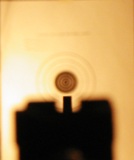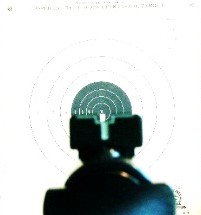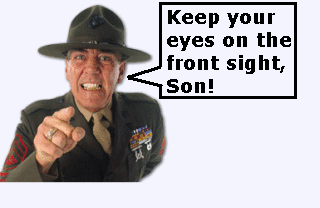Sight picture
Posted: Tue Aug 16, 2005 2:05 am
Here are some ideas on a variety of sight pictures.
A tangent 6 o'clock hold is very difficult for a beginning shooter to hold both mentally and physically. First, anyone can agree that newer shooters have less than steady aiming tendencies although they have a strong desire to hold a "perfect sight picture." The combination of these two factors leads to surges in adrenaline in the body and the overpowering need to jerk the trigger the instant the sight wavers into the perceived near perfect position. Jerking the trigger instantaneously destroys all prior sight alignment work in the last few precious milliseconds before cartridge detonation.
Here's how the Tangent sight picture appears.
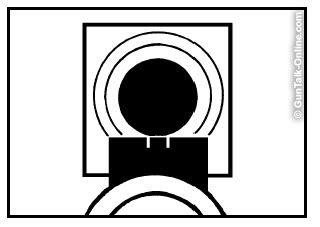
There are other problems with a tangential hold and these deal with the properties of light refraction. Light rays tend to bend around objects, so a tangent hold can be optically deceiving to the shooter. While the sight blade appears perfectly placed the light rays bending around it have really distorted where the target actually is positioned downrange. This effect is known as shooting a "flat tire." The black ball has distorted and now appears like it has a flat spot underneath it near the front sight. The resulting shots will be erratic on the target and can have a tendency to drift high in or above the aiming black.
Here's how a Flat Tire sight picture appears.
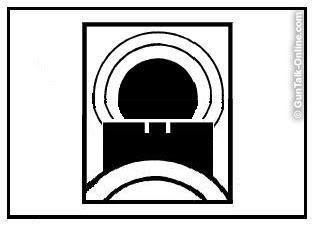
A sub 6 o'clock hold is preferred because light will not refract around the top of front blade when the sight is held a little lower on the aiming black. Service Rifle shooters use this method all the time where long distance is another added factor to contend with in competition.
The sub 6 o'clock aiming technique is also known as holding a "line of white." Actually the shooter holds just below the black ball and has a thin white line just above the sight blade and below the black ball. The aiming black does not distort with this style and the shots tend to cluster in the appropriate area on the target. The new shooter isn't attempting to hold perfect sight placement and therefore has less of a tendency to jerk the trigger. A shooter must be consistent with his line of white but not obsessive about it, this is very important, because the shooter will sooner or later realize that sight placement is not as important as sight alignment. In other words, there's a lot of wiggle room on the target and where the sights are isn't all that important as long as they're close. However, making sure that the front and rear sights are in alignment is critical because any offset here and an angular error is induced into the shot. Any angular irregularities in sight alignment and shots will appear normal to the shooter optically but the hits will be way off of his calls. That kind of situation injects frustration and strong emotions into the shooter's performance and a rapid decline in mental attitude occurs, causing even more negative emotional responses. The shooter cannot figure out why the shots are errant because they appeared to him as having been aimed correctly.
Here's how the Line of White sight picture appears.
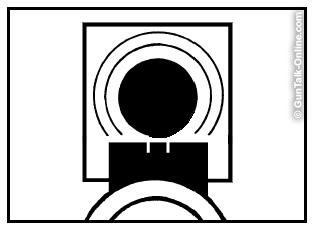
The center hold can be an effective hold style for a new shooter. Here the front sight is held dead center of the aiming black. All a shooter has to do is maintain alignment, hold the blade in the black, and if the shot breaks correctly, the hits will be in the black. The problem is, as the shooter's skills progress, hits just being in the black won't be good enough for consistent scores, the hits will be all over the black and not consistent. But before I get into the negatives there are a few more positives to this style of hold. A shooter can mostly concentrate on his/her trigger techniques instead of sight placement - an area where most of the shooter's concentration should be focused. Remember, no matter how perfect the sight alignment or hold is, an improperly executed trigger technique negates it all in the last few moments before the shot breaks.
Here's how the Center Hold sight picture appears.
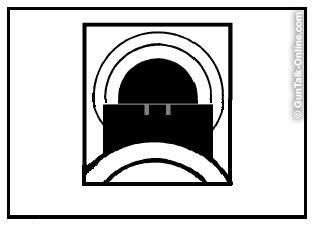
The center hold can be a difficult technique for a new shooter too. Optically, it is a lot more difficult to keep the front and rear sights aligned when the white area of the target isn't showing though in between the two sights. In the heat of sustained fire, not having two clear white lines in between the sights can cause the shooter to lose sight focus or get the blade and notch out of alignment. When this situation happens, the calls are way off and the shooter can even start looking downrange at the target instead of the sights were he/she should be looking.
OK, now for the real deal. It doesn't matter much on which technique a shooter uses, just pick one and be consistent with it. Make only minor changes to your shooting style techniques and then very carefully evaluate the results. Build yourself into a set routine and don't stray from it. A shooter, who does one thing one day and another next, is not being consistent in anything except being inconsistent. These things develop over time, it won't happen overnight. As your shooting skills and physical abilities increase, the performance level results will ascend like a set of stairs. Scores will jump a little then level off, then improve another notch and level off again. And be prepared for some setbacks as one tends to regress back to old poor habits from time to time. Most importantly, don't ever get frustrated, because then you're not concentrating on your shooting techniques with 100% of your focus. Anything less than 100% mental focus and performance will decline significantly. Shooting is very much like a martial art, the results come from executing the techniques perfectly, the means cause the results and not the other way around. Oh, and never forget to go out and have some fun.
R,
Bullseye
A tangent 6 o'clock hold is very difficult for a beginning shooter to hold both mentally and physically. First, anyone can agree that newer shooters have less than steady aiming tendencies although they have a strong desire to hold a "perfect sight picture." The combination of these two factors leads to surges in adrenaline in the body and the overpowering need to jerk the trigger the instant the sight wavers into the perceived near perfect position. Jerking the trigger instantaneously destroys all prior sight alignment work in the last few precious milliseconds before cartridge detonation.
Here's how the Tangent sight picture appears.

There are other problems with a tangential hold and these deal with the properties of light refraction. Light rays tend to bend around objects, so a tangent hold can be optically deceiving to the shooter. While the sight blade appears perfectly placed the light rays bending around it have really distorted where the target actually is positioned downrange. This effect is known as shooting a "flat tire." The black ball has distorted and now appears like it has a flat spot underneath it near the front sight. The resulting shots will be erratic on the target and can have a tendency to drift high in or above the aiming black.
Here's how a Flat Tire sight picture appears.

A sub 6 o'clock hold is preferred because light will not refract around the top of front blade when the sight is held a little lower on the aiming black. Service Rifle shooters use this method all the time where long distance is another added factor to contend with in competition.
The sub 6 o'clock aiming technique is also known as holding a "line of white." Actually the shooter holds just below the black ball and has a thin white line just above the sight blade and below the black ball. The aiming black does not distort with this style and the shots tend to cluster in the appropriate area on the target. The new shooter isn't attempting to hold perfect sight placement and therefore has less of a tendency to jerk the trigger. A shooter must be consistent with his line of white but not obsessive about it, this is very important, because the shooter will sooner or later realize that sight placement is not as important as sight alignment. In other words, there's a lot of wiggle room on the target and where the sights are isn't all that important as long as they're close. However, making sure that the front and rear sights are in alignment is critical because any offset here and an angular error is induced into the shot. Any angular irregularities in sight alignment and shots will appear normal to the shooter optically but the hits will be way off of his calls. That kind of situation injects frustration and strong emotions into the shooter's performance and a rapid decline in mental attitude occurs, causing even more negative emotional responses. The shooter cannot figure out why the shots are errant because they appeared to him as having been aimed correctly.
Here's how the Line of White sight picture appears.

The center hold can be an effective hold style for a new shooter. Here the front sight is held dead center of the aiming black. All a shooter has to do is maintain alignment, hold the blade in the black, and if the shot breaks correctly, the hits will be in the black. The problem is, as the shooter's skills progress, hits just being in the black won't be good enough for consistent scores, the hits will be all over the black and not consistent. But before I get into the negatives there are a few more positives to this style of hold. A shooter can mostly concentrate on his/her trigger techniques instead of sight placement - an area where most of the shooter's concentration should be focused. Remember, no matter how perfect the sight alignment or hold is, an improperly executed trigger technique negates it all in the last few moments before the shot breaks.
Here's how the Center Hold sight picture appears.

The center hold can be a difficult technique for a new shooter too. Optically, it is a lot more difficult to keep the front and rear sights aligned when the white area of the target isn't showing though in between the two sights. In the heat of sustained fire, not having two clear white lines in between the sights can cause the shooter to lose sight focus or get the blade and notch out of alignment. When this situation happens, the calls are way off and the shooter can even start looking downrange at the target instead of the sights were he/she should be looking.
OK, now for the real deal. It doesn't matter much on which technique a shooter uses, just pick one and be consistent with it. Make only minor changes to your shooting style techniques and then very carefully evaluate the results. Build yourself into a set routine and don't stray from it. A shooter, who does one thing one day and another next, is not being consistent in anything except being inconsistent. These things develop over time, it won't happen overnight. As your shooting skills and physical abilities increase, the performance level results will ascend like a set of stairs. Scores will jump a little then level off, then improve another notch and level off again. And be prepared for some setbacks as one tends to regress back to old poor habits from time to time. Most importantly, don't ever get frustrated, because then you're not concentrating on your shooting techniques with 100% of your focus. Anything less than 100% mental focus and performance will decline significantly. Shooting is very much like a martial art, the results come from executing the techniques perfectly, the means cause the results and not the other way around. Oh, and never forget to go out and have some fun.
R,
Bullseye
